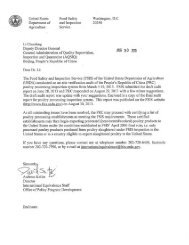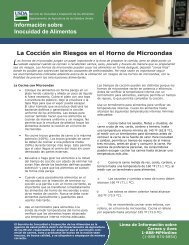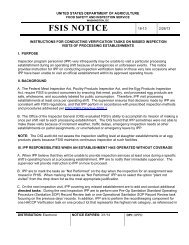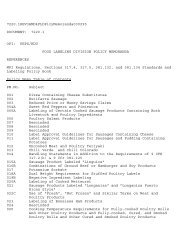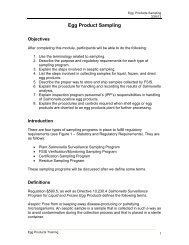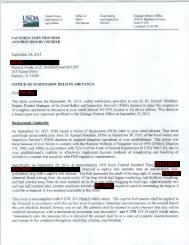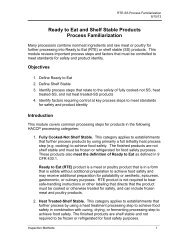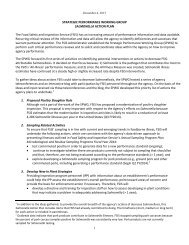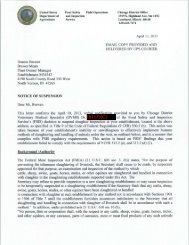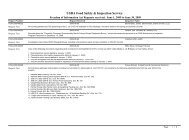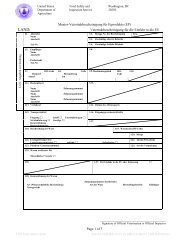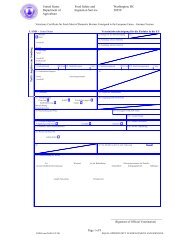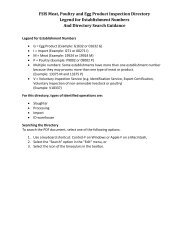FSIS Notice 20-13 - Food Safety and Inspection Service
FSIS Notice 20-13 - Food Safety and Inspection Service
FSIS Notice 20-13 - Food Safety and Inspection Service
Create successful ePaper yourself
Turn your PDF publications into a flip-book with our unique Google optimized e-Paper software.
UNITED STATES DEPARTMENT OF AGRICULTURE<br />
FOOD SAFETY AND INSPECTION SERVICE<br />
WASHINGTON, DC<br />
<strong>FSIS</strong> NOTICE <strong>20</strong>-<strong>13</strong><br />
3/12/<strong>13</strong><br />
INCREASED VERIFICATION BY INSPECTION PROGRAM PERSONNEL OF SANITARY <br />
DRESSING AT VEAL SLAUGHTER ESTABLISHMENTS<br />
I. PURPOSE<br />
This notice provides inspection program personnel (IPP) assigned to veal slaughter<br />
establishments additional information to use when verifying that sanitary dressing <strong>and</strong> process<br />
control procedures are preventing contamination of carcasses <strong>and</strong> the creation of insanitary<br />
conditions. For purposes of this notice, veal slaughter establishments include all<br />
establishments that slaughter bob veal, formula-fed veal, non-formula fed veal, <strong>and</strong> heavy<br />
calves.<br />
II. BACKGROUND<br />
A. <strong>FSIS</strong> test results show that the percent positive rate for Shiga toxin-producing Escherichia<br />
coli (STEC) from trimmings produced from veal appears to be higher than that for trimmings<br />
produced from other cattle slaughter classes. Following up on these results, <strong>FSIS</strong> conducted a<br />
review of <strong>Food</strong> <strong>Safety</strong> Assessments (FSAs) <strong>and</strong> onsite visits to veal slaughter establishments to<br />
identify concerns unique to veal slaughter.<br />
The results of the review showed that:<br />
1. Many veal slaughter establishments may not have implemented sanitary dressing<br />
<strong>and</strong> process control procedures sufficient to prevent contamination of carcasses <strong>and</strong><br />
the creation of insanitary conditions.<br />
2. The amount of contamination from deficient sanitary dressing procedures likely<br />
overwhelmed the decontamination <strong>and</strong> antimicrobial intervention treatments. These<br />
sanitary dressing deficiencies contributed to the production of products contaminated<br />
with STEC.<br />
B. Based on results of the analyses, IPP need to verify that veal slaughter establishments are<br />
consistently focusing on their sanitary dressing <strong>and</strong> process control procedures, <strong>and</strong> that these<br />
establishments are preventing carcass contamination (9 CFR 310.18(a)) <strong>and</strong> the creation of<br />
insanitary conditions in their operations (9<br />
CFR 416.1). 9 CFR 416.1 through 416.5 require that establishments maintain sanitary<br />
conditions.<br />
C. <strong>FSIS</strong> issuances related to beef also apply to veal. <strong>FSIS</strong> inspection program personnel<br />
assigned to veal establishments are to follow the directions in the following issuances:<br />
DISTRIBUTION: Electronic NOTICE EXPIRES: 4/1/14 OPI: OPPD
1. <strong>FSIS</strong> Directive 10,010.1 Rev. 3, Verification Activities for Escherichia coli O157:H7 in<br />
Raw Beef Products, <strong>and</strong><br />
2. <strong>FSIS</strong> PHIS Directive 6410.1 Rev. 1, Verifying Sanitary Dressing <strong>and</strong> Process Control<br />
Procedures by Off-line <strong>Inspection</strong> Program Personnel (IPP) in Slaughter Operations of<br />
Cattle of Any Age.<br />
III. INITIAL INSPECTION PROGRAM PERSONNEL RESPONSIBILITIES<br />
A. After receipt of this notice, at the next weekly meeting, IPP assigned to veal slaughter<br />
establishments are to meet with establishment management. IPP are to inform establishment<br />
management that:<br />
1. IPP will be performing the Beef Sanitary Dressing task at an increased frequency. IPP<br />
will perform the sanitary dressing task at least twice a week for the next 90 days. IPP will<br />
follow the methodology in <strong>FSIS</strong> PHIS Directive 6410.1 Rev. 1, Verifying Sanitary<br />
Dressing <strong>and</strong> Process Control Procedures by Off-line <strong>Inspection</strong> Program Personnel<br />
(IPP) in Slaughter Operations of Any Age.<br />
2. The purpose of this activity is to verify that veal slaughter establishments have<br />
implemented sanitary dressing <strong>and</strong> process control procedures to prevent contamination<br />
of carcasses (9 CFR 310.18(a)) <strong>and</strong> to ensure that insanitary conditions are not created<br />
(9 CFR 416.1 <strong>and</strong> 416.2-416.5, as applicable).<br />
B. IPP are to document this meeting in a Memor<strong>and</strong>um of Interview (MOI) according to <strong>FSIS</strong><br />
PHIS Directive 5000.1, Verifying an Establishment’s <strong>Food</strong> <strong>Safety</strong> System <strong>and</strong> to provide a copy<br />
of the MOI to establishment management.<br />
IV. SANITARY DRESSING VERIFICATION<br />
A. Routinely, IPP perform the Beef Sanitary Dressing task once every other week. However,<br />
IPP assigned to veal slaughter establishments are to perform the Beef Sanitary Dressing task at<br />
an increased frequency for the next 90 days.<br />
1. IPP assigned to veal slaughter establishments are to perform the Beef Sanitary<br />
Dressing task at least twice a week for the next 90 days by adding directed tasks.<br />
2. IPP are to follow the methodology <strong>FSIS</strong> PHIS Directive 6410.1 Rev. 1, Verifying Sanitary<br />
Dressing <strong>and</strong> Process Control Procedures by Off-line <strong>Inspection</strong> Program Personnel (IPP)<br />
in Slaughter Operations of Any Age.<br />
B. IPP are to follow the instructions in <strong>FSIS</strong> PHIS Directive <strong>13</strong>,000.1 Rev. 1, Scheduling In-plant<br />
<strong>Inspection</strong> Tasks in the Public Health Information System (PHIS) when scheduling their<br />
inspection tasks. IPP are to designate any unscheduled tasks that they did not complete as “not<br />
performed” as a result of the increased frequency of the Beef Sanitary Dressing task. IPP are to<br />
select “Higher priority task took precedent” as the reason code.<br />
2
C. IPP are to record any non-compliances identified on a noncompliance record (NR) according<br />
to <strong>FSIS</strong> PHIS Directive 6410.1 <strong>and</strong> <strong>FSIS</strong> PHIS Directive 5000.1, Verifying an Establishment’s<br />
<strong>Food</strong> <strong>Safety</strong> System including associating noncompliance records (NRs), where appropriate.<br />
D. Examples of situations when it is appropriate for IPP to associate NRs include:<br />
1. Two or more NRs documented while performing the Beef Sanitary Dressing task;<br />
2. One NR indicates that the establishment’s corrective actions for a previous sanitary<br />
dressing NR were not implemented or did not prevent recurrence; <strong>and</strong><br />
3. One or more NRs in response to a positive <strong>FSIS</strong> STEC result in trimmings.<br />
E. When the information gathered suggests that the establishment has lost process control, IPP<br />
are to determine whether the establishment has taken corrective actions to bring the process<br />
back under control. IPP are to verify that the establishment’s corrective actions are effective<br />
<strong>and</strong> prevent recurrence. IPP are to consult with their immediate supervisor for assistance in<br />
making this determination, if needed. IPP are to request a for-cause FSA through supervisory<br />
channels if the establishment repeatedly fails to take corrective action, or if the corrective actions<br />
the establishment takes are ineffective. Examples of the types of findings that can indicate a loss<br />
of control are provided in Section VIII of <strong>FSIS</strong> PHIS Directive 6410.1. Specific findings in FSAs<br />
that have evidenced that veal slaughter establishments were losing process control include:<br />
1. Multiple positive STEC results in raw beef manufacturing trimmings from <strong>FSIS</strong> routine<br />
<strong>and</strong> follow-up samples;<br />
2. Generic E. coli results from establishment testing that indicate increasing microbial<br />
contamination on carcasses; <strong>and</strong><br />
3. An establishment not evaluating testing results, including generic E. coli on carcasses<br />
<strong>and</strong> STEC on beef manufacturing trimmings, to help determine how the results impact<br />
veal slaughter operations.<br />
F. Attachment 1 provides information on <strong>and</strong> examples of sanitary dressing deficiencies <strong>and</strong><br />
ineffective application of interventions that have been observed at veal slaughter<br />
establishments. IPP are to use the information in Attachment 1 to assist them in verifying<br />
sanitary dressing in veal slaughter establishments.<br />
G. If the establishment’s slaughter <strong>and</strong> sanitary dressing procedures are out of control, the level<br />
of contamination may affect IPP’s ability to perform proper post-mortem inspection procedures.<br />
The Public Health Veterinarian (PHV) or Inspector-in-Charge (IIC) is to determine whether this<br />
is the case. If it is, the PHV or IIC is to reduce the line speed in accordance with 9 CFR<br />
310.1(b)(1). (See Section XI. E. of <strong>FSIS</strong> PHIS Directive 6410.1 Verifying Sanitary Dressing <strong>and</strong><br />
Process Control Procedures by Off-line <strong>Inspection</strong> Program Personnel (IPP) in Slaughter<br />
Operations of Cattle of Any Age)<br />
V. SUPERVISORY PERSONNEL RESPONSIBILITIES<br />
A. “Supervisory personnel” refers to any Office of Field Operations (OFO) personnel that<br />
supervise IPP who conduct off-line verification activities in cattle (including veal) slaughter<br />
operations.<br />
B. Supervisory personnel with one or more veal slaughter establishments within their circuit are<br />
3
to conduct a work unit meeting with IPP assigned to veal slaughter establishments. Supervisory<br />
personnel are to review the inspection methodology in <strong>FSIS</strong> PHIS Directive 6410.1 <strong>and</strong> the<br />
information in this <strong>Notice</strong>.<br />
C. Supervisory personnel are to conduct an on-site visit to veal slaughter establishments in<br />
their circuit within 90 days of this issuance.<br />
D. Supervisory personnel are to ensure that IPP are correctly prioritizing inspection tasks, are<br />
correctly applying the inspection methodology, are making informed decisions, are properly<br />
documenting findings, <strong>and</strong> are taking the appropriate enforcement actions as instructed in this<br />
notice <strong>and</strong> <strong>FSIS</strong> PHIS Directive 6410.1.<br />
E. Supervisory personnel are to refer to the current version of the <strong>FSIS</strong> Guide for Conducting<br />
In-Plant Performance System (IPPS) Assessments for additional guidance <strong>and</strong> instructions.<br />
VI. DATA ANALYSIS<br />
Members of the Risk, Innovations, <strong>and</strong> Management Division (RIMD), Office of Policy <strong>and</strong><br />
Program Development, will analyze data from Shiga toxin-producing Escherichia coli (STEC)<br />
sampling programs <strong>and</strong> <strong>Food</strong> <strong>Safety</strong> Assessments (FSA) performed at veal slaughter<br />
establishments to determine whether veal slaughter establishments have adequately<br />
addressed hazards. RIMD will analyze data to determine whether the frequency of sanitary<br />
dressing verification for veal should be different than other cattle slaughter classes.<br />
Members of the Data Analysis <strong>and</strong> Integration Group (DAIG), Office of Data Integration <strong>and</strong><br />
<strong>Food</strong> Protection, will analyze PHIS data to determine whether IPP at veal slaughter<br />
establishments performed the beef sanitary dressing task at the increased frequency.<br />
VII. QUESTIONS<br />
Refer questions regarding this notice to the Risk, Innovations, <strong>and</strong> Management Division <br />
through ask<strong>FSIS</strong> or by telephone at 1-800-233-3935. When submitting a question, use the <br />
Submit a Question tab, <strong>and</strong> enter the following information in the fields provided:<br />
Subject Field: Enter <strong>FSIS</strong> <strong>Notice</strong> <strong>20</strong>-<strong>13</strong><br />
Question Field: Enter question with as much detail as possible.<br />
Product Field: Select General <strong>Inspection</strong> from the drop-down menu. <br />
Category Field: Select Sampling E. coli O157:H7 from the drop-down menu.<br />
Policy Arena: Select Domestic (U.S.) Only from the drop-down menu.<br />
When all fields are complete, press the Submit button.<br />
Assistant Administrator<br />
Office of Policy <strong>and</strong> Program Development<br />
4
Attachment 1 Observed Sanitary Dressing Deficiencies <strong>and</strong> Ineffective Application of<br />
Interventions at Veal Slaughter Establishments<br />
<strong>FSIS</strong> conducted a review of <strong>Food</strong> <strong>Safety</strong> Assessments (FSAs) <strong>and</strong> onsite visits to identify<br />
concerns unique to veal slaughter. The results of the review indicated that many veal slaughter<br />
establishments have not implemented sanitary dressing <strong>and</strong> process control procedures<br />
sufficient to prevent carcass contamination <strong>and</strong> the creation of insanitary conditions.<br />
This attachment includes examples of sanitary dressing deficiencies <strong>and</strong> ineffective application<br />
of interventions that <strong>FSIS</strong> observed repeatedly during on-site visits. IPP are to use this<br />
information in conjunction with the inspection methodology in <strong>FSIS</strong> PHIS Directive 6410.1 to<br />
assist them while verifying sanitary dressing in veal slaughter establishments. The attachment<br />
includes the relevant section (slaughter process step) in <strong>FSIS</strong> PHIS Directive 6410.1 to<br />
facilitate this process.<br />
Sticking<br />
In this photo, we see that the establishment uses a large cut to bleed the calf, <strong>and</strong> that ingesta is<br />
leaking from the esophagus during bleeding (yellow arrow). <strong>FSIS</strong> observed employees cutting<br />
through the weas<strong>and</strong> (esophagus) during sticking. This practice resulted in ingesta<br />
contaminating the carcass <strong>and</strong> head. <strong>FSIS</strong> also observed employees removing the head<br />
without closing the weas<strong>and</strong>. <strong>FSIS</strong> recommends that the establishment use the smallest cut<br />
possible to accomplish bleeding <strong>and</strong> not to cut the weas<strong>and</strong> during sticking <strong>and</strong> bleeding. <strong>FSIS</strong><br />
recommends that establishments close the weas<strong>and</strong> after rodding prior to head removal.<br />
Photo 1 Cutting through the weas<strong>and</strong> (esophagus) during sticking<br />
5
Hide removal<br />
Onsite visits to veal slaughter establishments <strong>and</strong> reviews of FSAs showed that<br />
establishments were cutting through the hide <strong>and</strong> further dressing the carcass without sanitizing<br />
knives, gloves, <strong>and</strong> equipment adequately to prevent the creation of insanitary conditions. An<br />
example would be an employee making a “dirty cut” (one through the hide, left photo) <strong>and</strong><br />
continuing to cut through aitchbone (yellow arrow) without sanitizing the knife after making the<br />
dirty cut. Another example (not pictured) of this would be a veal slaughter establishment further<br />
processing veal carcasses with the hide-on. Proper hide removal is a critical step in preventing<br />
carcass contamination <strong>and</strong> the creation of insanitary conditions. While opening the hide (except<br />
for the original incisions for sticking <strong>and</strong> starting the skinning operations at the poll <strong>and</strong> shanks),<br />
<strong>FSIS</strong> recommends that the employee direct the knife blade toward the hair side of the skin to<br />
prevent contaminating the flesh with cut hair (not shown). After making the “dirty cut” <strong>and</strong><br />
exiting the hide, <strong>FSIS</strong> recommends that the employee sanitize his knife <strong>and</strong> glove before<br />
making another cut (in this case, cutting through to the aitchbone, right photo).<br />
6
Bunging<br />
This concept of sanitizing after the “dirty cut” can also be seen with bunging. The employee<br />
makes the “dirty cut,” in this case cutting around the tissue surrounding the anus (yellow arrow,<br />
top left photo). The employee then sanitizes his knife <strong>and</strong> gloves before further cutting the<br />
exposed tissue ( top right photo). <strong>FSIS</strong> recommends that establishments remove the hide prior<br />
to cutting into the carcass. Tying <strong>and</strong> bagging the bung (not shown) is also an important step to<br />
preventing carcass contamination.<br />
7
Bunging<br />
These photos show the impact of the establishment failing to bag <strong>and</strong> tie the bung. The<br />
contaminated bung is contacting the exposed carcass (yellow arrows). When establishments<br />
apply hot water or antimicrobial interventions to an exposed bung, it further spreads<br />
contamination. <strong>FSIS</strong> recommends that establishments tie <strong>and</strong> bag the bung in a sanitary<br />
manner.<br />
8
Hide removal<br />
Legging<br />
9
These photos show the “legging” process, a part of the hide removal process during which the<br />
establishment personnel remove the hide from the hindlimbs. Establishment personnel may<br />
introduce contamination at the pattern lines (along the incision lines through the hide, as the<br />
arrows show in the two bottom pictures). It is important that establishments prevent<br />
contamination throughout the slaughter process <strong>and</strong> remove contamination promptly when it<br />
occurs. The establishment can do this through knife trimming or steam vacuuming.<br />
10
Hide Removal<br />
Sanitize <strong>and</strong> Remove Debris from<br />
Steam Vacuum<br />
Steam vacuuming is a useful intervention for establishments to apply along the pattern lines <strong>and</strong><br />
for removing incidental contamination. <strong>FSIS</strong> observed (not shown) employees applying heavily<br />
contaminated steam vacuums to carcasses. The purpose of these photos is to remind IPP of<br />
the importance of cleaning <strong>and</strong> sanitizing equipment as often as necessary to prevent the<br />
creation of insanitary conditions <strong>and</strong> cross contamination.<br />
11
Hide Removal<br />
These photos show hide <strong>and</strong> hair touching the carcass when being removed, potentially allowing<br />
the dirty exterior side to touch the carcass. In the bottom left photo, the leg hide flaps are<br />
contacting the carcass. The bottom right photo shows hide flaps that have curled under after<br />
hide removal (as seen inside the yellow oval) <strong>and</strong> are contacting the carcass. <strong>FSIS</strong><br />
recommends that establishments prevent the hide from contacting the carcass during hide<br />
removal. The photo below shows the use of hide clips as one method of preventing hide from<br />
contacting the carcass.<br />
12
Evisceration<br />
These photos show the establishment puncturing the paunch <strong>and</strong> intestines during evisceration<br />
(top photo, at blue arrow) causing carcass contamination with ingesta (bottom photo, inside<br />
yellow oval). <strong>FSIS</strong> recommends that establishments perform proper sanitary dressing<br />
procedures during evisceration to prevent puncturing the paunch <strong>and</strong> intestines.<br />
14
Hide removal (wash cabinets)<br />
This photo shows cross contamination of heads from a spray applied to the carcass (water<br />
sprayed onto carcass in the direction of the arrows, water spray seen within the yellow oval).<br />
The establishment failed to take measures (e.g., adequate distance or shields) to prevent cross<br />
contamination of adjacent heads. Cross contamination (not shown) can also occur while<br />
employees spray equipment, the floor, <strong>and</strong> other surfaces if the establishment does not take<br />
appropriate precautions to prevent overspray from contacting carcasses. Also, it is important<br />
that carcasses are free of visible contamination prior to entering wash cabinets or the manual<br />
application of water or antimicrobial sprays. Otherwise, the intervention could further spread the<br />
contamination.<br />
15
Establishment Interventions<br />
Failure to Implement Interventions<br />
Effectively<br />
These photos show the practice of suspending a carcass from a single hook, which prevents<br />
antimicrobial <strong>and</strong> hot water interventions from achieving carcass/product coverage. Carcass<br />
coverage –ensuring that the entire carcass surface is treated -- is necessary for the intervention<br />
to operate effectively <strong>and</strong> as intended. Additional information is included in <strong>FSIS</strong> <strong>Notice</strong> 17-12<br />
Verification of Antimicrobial Intervention Coverage of Carcass or Product at Veal Slaughter <strong>and</strong><br />
Beef Fabrication Establishments. IPP verify that establishments are implementing their<br />
interventions effectively (i.e., according to the establishment’s scientific support) during the<br />
observation component of the appropriate Hazard Analysis <strong>and</strong> Critical Control Point (HACCP)<br />
verification task.<br />
16
Establishment Interventions<br />
These photos show the establishment’s failure to implement its trim antimicrobial intervention<br />
spray effectively. The intervention did not achieve full product coverage. Product coverage is<br />
essential for the intervention to be effective. Both pictures show that the establishment only<br />
applies the intervention to the top side of the trim. These pictures also show product that is<br />
folded on top of itself so that not all product surfaces received the intervention (in the left picture<br />
each piece has a single fold, <strong>and</strong> in the right picture the trim is piled up). The picture on the<br />
right shows clearly that the arc of the spray nozzles (inside each yellow line) is not sufficient to<br />
reach product on the sides of the conveyor belt (yellow arrows).<br />
17
Results of Sanitary Dressing<br />
Deficiencies <strong>and</strong> Ineffective<br />
Application of Interventions<br />
18
In these photos, we see contamination in the bung area (top left photo), boneless veal legs (top<br />
right photo under arrow), breast <strong>and</strong> shank areas (middle photos under arrow <strong>and</strong> within ovals),<br />
<strong>and</strong> along the thigh (bottom photo). This contamination resulted from the establishment’s failure<br />
to implement sanitary dressing procedures to prevent the creation of insanitary conditions <strong>and</strong><br />
contamination of carcasses, <strong>and</strong> its failure to implement antimicrobial interventions effectively.<br />
Positive STEC test results are a reflection of an establishment’s slaughter controls <strong>and</strong> provide<br />
evidence that the establishment is not implementing its slaughter controls effectively to produce<br />
safe, unadulterated products.<br />
19



